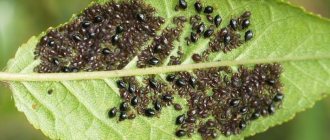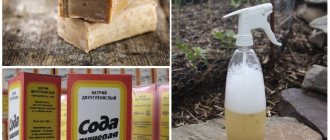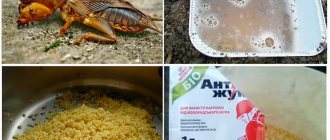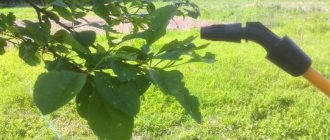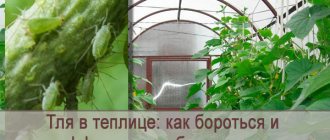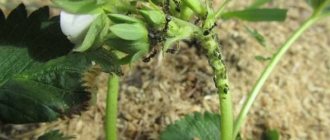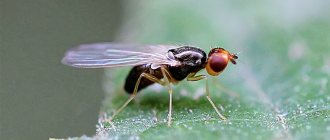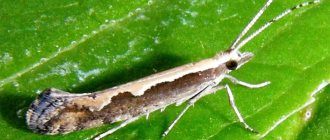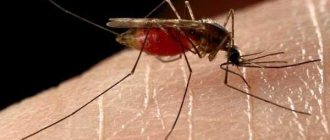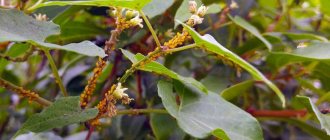How to get rid of aphids on cucumbers and how to deal with it It is necessary to know not only for beginners, but also for experienced gardeners. After all, this pest is capable of destroying the entire crop. It is necessary to combat these pests from spring in the greenhouse and from July in open ground. And this must be done quickly, since aphids reproduce in a short time and in just a week can infect all cucumber plantings, leaving the gardener without a harvest. Therefore, in this article we will talk about how to fight aphids on cucumbers folk, biological and chemical means.
What are aphids and how are they dangerous for plants, including cucumbers?
There are many types of aphids. Pumpkin crops, including cucumbers, are affected by melon aphids. Cabbage, legumes (beans, peas) and tomatoes, eggplants, and peppers also suffer from aphids.
The pest reaches no more than 2 mm in length, and it multiplies very quickly, occupying all garden beds in a matter of days.
The melon aphid damages the leaves and young shoots by piercing them and sucking the juice from the plants. As a result, the shoots stop growing, stop forming fruits, and the plant soon dies.
In addition, aphids are carriers of dangerous viral diseases, which can cause the death of neighboring crops.
The pest settles on the back side of the leaves, so it can be replaced at the wrong time.
Signs of aphids on cucumbers:
- the edges of the leaves curl down;
- deformation of the tops of the stems occurs;
- the plant stops growing;
- internodes are shortened;
- fruit formation is reduced;
- plants are covered with honeydew;
- ants appear;
- the ovaries fall off;
- the lower leaves wither;
- Small black bugs appeared on the back of the leaves.
Causes
Many factors contribute to the appearance of this type of dangerous pest in areas. Therefore, it is necessary to begin the fight by eliminating all possible causes of the origin of these insects in the beds:
- Ants feed on sweet juice (honeydew), formed during the life of aphids, which accumulates on the underside of leaves. They transfer insects to young plants, where females begin laying eggs. Ants also carry the larvae, spreading them throughout the area.
- Failure to comply with agrotechnical conditions is a favorable factor for the appearance of aphids:
- dense and frequent planting of cucumbers;
- weeding not carried out on time;
- high nitrogen content in the soil;
- poor ventilation in greenhouses;
- high humidity;
- no direct sunlight.
- This type of pest survives the winter on weedy plants. Therefore, it is important to prevent grass from growing in the area. It is also necessary to remove pulled out weeds from the beds immediately after weeding.
How to treat cucumbers against aphids: folk methods of fighting aphids on cucumbers
Important! To completely destroy melon aphids on cucumbers, it is necessary to carry out 2-3 treatments with an interval of 3-4 days. At the same time, various folk remedies are used so that the pest cannot adapt to them.
Treatment of cucumbers against aphids is carried out in the evening after sunset on the back side of the leaves.
Ammonia (ammonia solution)
10% ammonia effectively fights aphids.
Solution recipe:
- 10 liters of water;
- 50 ml. ammonia;
- 5 tbsp. spoons of liquid laundry soap;
- 3 tbsp. spoons of sunflower oil.
Interesting! Liquid soap enhances the adhesion of the solution to the leaves, and oil enhances the effectiveness of the product.
Mustard powder
Mustard powder is good for controlling aphids. The solution is prepared as follows:
- 100 g powder;
- 3 liters of boiling water;
- Leave for 5-6 hours (stirring occasionally);
- after the mustard settles, the liquid is poured into a 10-liter sprayer
- add 5 tbsp. spoons of liquid laundry soap;
- 3 tbsp. spoons of sunflower oil;
- 7 liters of water.
- Spraying is carried out.
Soda
Baking soda works great against aphids. Preparation of the solution:
- 10 liters of water;
- 50 g of soda (3 tablespoons);
- 5 tbsp. spoons of liquid laundry soap;
- 3 tbsp. spoons of sunflower oil.
Interesting! Soda solution is also effective against powdery mildew and rot.
Vinegar
To treat cucumbers against aphids, prepare the following solution:
- 1 tbsp. spoon of acetic acid;
- 1 liter of water;
- 1 tbsp. spoon of laundry soap or detergent.
In further recipes you need to add soap, but you can discard the oil.
Wood ash
- 200 g of ash;
- 10 liters of water;
- stand for 12 hours;
- then add 2-3 tbsp. spoons of soap, grated.
Interesting! Products based on plants that emit a pungent odor are effective: celandine, garlic, onion skins and others.
Laundry or tar soap
- Finely grate 100 g of soap;
- pour 10 liters of water.
Garlic
- 150 g crushed;
- add to 10 liters of boiling water;
- stand for 24 hours;
- filter.
Onion peel
- 200 g husk;
- 10 liters of water;
- stand for 4-5 days;
- strain.
Pine needle extract
- 1 tbsp. spoon of extract;
- 2-3 tbsp. spoons of liquid soap;
- a bucket of water.
Tobacco dust
- 2 cups of tobacco dust;
- 10 liters of water;
- Infuse for 1 day;
- filter;
- add 50 g of crushed laundry soap.
In the same way, you can prepare not an infusion, but a decoction. In this case, the mixture will need to be simmered for 30 minutes after boiling.
Tops of tomatoes and potatoes
- 3 liter jar.
- Fill it ½ full with tops.
- Boiling water is poured to the brim.
- They insist for a day.
- Rub 1 tbsp. a spoonful of laundry soap.
Celandine
Infusion of celandine is an effective remedy for aphids on cucumbers.
- 3-4 kg of freshly cut green grass or 1 kg of dry;
- 10 liters of water;
- stand for 1-2 days;
- filter;
- add 2-3 tbsp. spoons of soap (grate).
Yarrow
- 1 kg of flowers and leaves;
- fill the bucket with boiling water to the brim;
- leave for 4-5 days;
- drain the liquid into another container;
- add 2-3 tablespoons of previously crushed soap to it.
Chamomile
- 10 liters of boiling water;
- 1 kg of pharmaceutical chamomile;
- leave for 12 hours.
- dilute with water 1:3;
- rub laundry soap (40 g per 10 liters of solution).
Sorrel
- 300 g horse sorrel roots;
- 10 liters of boiling water;
- Infuse for 2 hours;
- filter and spray.
How to protect seedlings
Seedlings are often grown directly in an apartment and the use of pesticides is undesirable. In this case, to combat pests, folk remedies will be the best option.
Ammonia against aphids will not only destroy insects, but also support seedlings. Ammonia is an aqueous solution of ammonium hydroxide. Strictly speaking, ammonia against aphids can only be used in a greenhouse, filling it with this gas. But in everyday life, ammonia and ammonia are perceived as synonyms. Therefore, ammonia for aphids is often used by dissolving 5 ml of ammonia in a liter of water.
On a note!
Ammonia repels pests with a pungent odor, and the nitrogen it contains promotes the growth of seedlings.
Hydrogen peroxide against aphids is not considered by experienced gardeners. It is good as a disinfectant against fungal diseases, which can replace the traditional manganese solution in which seeds are soaked before planting. It is also used as a growth stimulant. This composition:
- liter of water;
- 2 tbsp. spoons of ethyl alcohol 76%;
- 3 drops of liquid soap;
- 50 ml of 3 percent peroxide.
Biological agents
If aphids have already infected many cucumber plantings, then it is necessary to resort to treatment with special fungicides: biological and chemical. Effective biological preparations for controlling aphids on cucumbers include the following:
- Bitoxibacillin;
- Aktofit;
- Biotlin;
- Fitoverm.
Fitoverm allows you to destroy pests very quickly: 2 hours after treatment they stop feeding, and after 2 days they die.
You can also use “Healthy Garden” against aphids, the main thing is to double the dosage - 4 granules per 1 liter of water). It lasts for 2-3 weeks, after which you can spray it again.
Moreover, already 3-5 days after processing, the fruits can be used for food again.
Common mistakes
- Incorrect dosage for spraying cucumbers. If the concentration of the product is low, it will not be effective, and if it is high, the plant may die.
- Carrying out processing during the daytime. Spray the plants only in the morning and evening to avoid sunburn due to water remaining on the leaves of the cucumbers.
- Too frequent processing. Plants must be sprayed according to the recommendations for the use of drugs. Use folk remedies no more than once a week.
Chemicals
Most often, after several treatments of cucumbers with folk or biological remedies, the aphids disappear. However, it happens that the pest remains. Then it is necessary to use chemical insecticides: systemic or surface.
| Name | Consumption rates, 10 l of water | After treatment, wait days before harvesting | Peculiarities |
| Inta-vir | 1 tab | 3 | do not use during flowering, toxic to bees |
| Aktellik | 3-15 ml | 20 | |
| Karbofos | 10 ml | 20 | |
| Spark Bio | 77 ml | 2 | |
| Iskra M | 10 ml | 20 | |
| Iskra Golden | 5 ml | 3 | |
| Fufanon | 10 ml | 20 | |
| Fufanon-Nova | 13 ml | 2 | |
| Commander | 5 ml | 3 |
The disadvantage of using chemicals is the long wait time for the substance to be removed. That is, the fruits can be eaten only 3-4 weeks after processing. Before this, the fruits will need to be picked and thrown away.
Symptoms of a pest
In the initial stages of crop damage, it can be difficult to notice small bugs. It is important to pay attention to the characteristic signs in time:
- the plant has a general sluggish appearance, lags behind in development and growth;
- the leaves dry out and curl, yellow-brown spots appear on them;
- the leaves become sticky to the touch due to the secretion of honeydew by aphids;
- the ovaries dry out and fall off;
- young shoots turn yellow and die;
- A large number of ants appear on the site.
When aphids appear, the plant has a lethargic appearance.
In the future, it is very easy to detect the pest. Whole groups of aphids are found everywhere: on leaves, stems, young shoots and ovaries. Active reproduction and population growth are promoted by high humidity and temperature.
Advice from expert gardeners on preventive measures
Experienced gardeners recommend the following to prevent aphids on cucumbers:
- Regularly inspect the back of the leaves.
- If there are any signs of infection, treat with folk remedies.
- If traditional methods do not produce results, use biological and chemical agents.
- Regularly apply potassium-phosphorus fertilizers.
- At the same time, you need to fight the ants.
- Remove weeds in a timely manner.
- Immediately remove and burn the affected parts of the plant.
- Wash the bushes before flowering by sprinkling.
- Varieties that are resistant to insects are grown.
- Protect ventilation openings in greenhouses with mesh or gauze.
- Cover the cucumbers with a thin cloth in the open ground.
- Treat seeds and soil before sowing.
- In the fall, disinfect the greenhouse with sulfur bombs.
- Change spraying preparations so that the pest does not adapt to them.
- Do not thicken the plantings.
Using various means and preparations to combat aphids on cucumbers, you can choose the optimal ones that will allow you to get rid of the malicious pest and save your crop.
Watch the video! Aphids on cucumbers: the best ways to fight them
Preventive measures
The appearance of black aphids on an open plot of land and in a greenhouse can be prevented by adhering to the following simple preventive measures:
- From time to time, fluff up the soil under the cucumbers. Simultaneously with loosening, weed the weeds.
- Eliminate ant colonies. Use effective chemicals or traditional methods for this.
- Plan planting cucumbers in such a way that the plants are not crowded in continuous rows in the future.
- Irrigate cucumber bushes 2 times a season with a solution of laundry soap.
- With the onset of summer, carefully examine the plants in the greenhouse, looking under each leaf. Ventilate the greenhouse regularly. Sometimes leave it open all night.
- In the spring , before planting seedlings, treat the entire greenhouse structure and the ground with karbofos.
As you can see, many means of combating aphids on cucumber plantings have been developed, and they are all effective in their own way. The main thing is to alternate different means so that the parasite does not get used to the previously used substance. However, it is much more important to follow preventive measures that will prevent the appearance of a dangerous insect.
Agrotechnical methods
Correct agrotechnical measures will help preserve the harvest. Planting seedlings no closer than 30 cm from each other. Do not plant seedlings too closely together. Aphids love warm places with poor ventilation. Regular weeding, until the onset of cold weather. Avoid the appearance of milkweed and shepherd's purse on the site; aphids love to spend the winter in them.
Extermination of anthills near garden beds. While looking for food, the insect flies from one area to another. And its larvae can be carried by ants, which are attracted by the sweet mucus of aphids; they crawl after it from one place to another place. New plantings are becoming infected.
To get rid of ants, you can purchase the Anteater product. It must be diluted with water following the instructions, then remove the top layer of soil from the anthill; when the white larvae are visible, thoroughly water it with the prepared solution. Next, water the paths along which they crawl.
You can prepare an ant repellent yourself; for this you need to take 10 g of boric acid, 0.5 cups of sugar, 0.5 cups of water. Mix thoroughly and spread the mixture onto pieces of cardboard. Place them around anthills. Another method is to pour boiling water over anthills. This will most likely need to be repeated several times. Constantly loosening the soil, especially in areas where their trails pass, can help.
To destroy pests, foliar fertilizing with phosphorus and potassium fertilizers is necessary. You need 20 g of superphosphate, 10 g of potassium chloride, add 10 liters of water. Spray cucumbers with this liquid until the aphids are completely destroyed.
